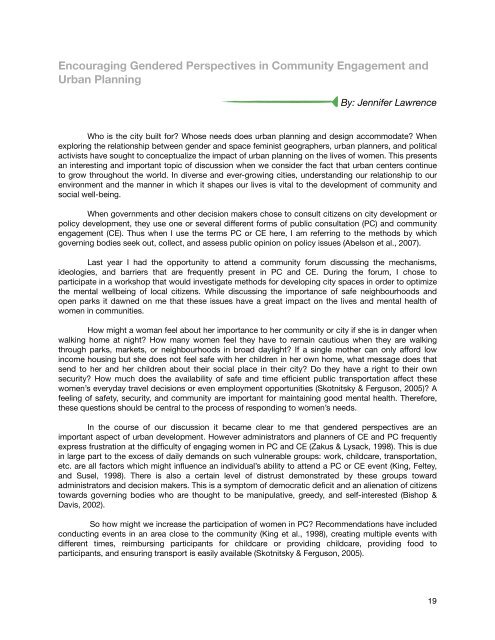Undercurrent-Issue-Fall-Winter-2014-3
Undercurrent-Issue-Fall-Winter-2014-3
Undercurrent-Issue-Fall-Winter-2014-3
You also want an ePaper? Increase the reach of your titles
YUMPU automatically turns print PDFs into web optimized ePapers that Google loves.
Encouraging Gendered Perspectives in Community Engagement andUrban PlanningBy: Jennifer LawrenceWho is the city built for? Whose needs does urban planning and design accommodate? Whenexploring the relationship between gender and space feminist geographers, urban planners, and politicalactivists have sought to conceptualize the impact of urban planning on the lives of women. This presentsan interesting and important topic of discussion when we consider the fact that urban centers continueto grow throughout the world. In diverse and ever-growing cities, understanding our relationship to ourenvironment and the manner in which it shapes our lives is vital to the development of community andsocial well-being.When governments and other decision makers chose to consult citizens on city development orpolicy development, they use one or several different forms of public consultation (PC) and communityengagement (CE). Thus when I use the terms PC or CE here, I am referring to the methods by whichgoverning bodies seek out, collect, and assess public opinion on policy issues (Abelson et al., 2007).Last year I had the opportunity to attend a community forum discussing the mechanisms,ideologies, and barriers that are frequently present in PC and CE. During the forum, I chose toparticipate in a workshop that would investigate methods for developing city spaces in order to optimizethe mental wellbeing of local citizens. While discussing the importance of safe neighbourhoods andopen parks it dawned on me that these issues have a great impact on the lives and mental health ofwomen in communities.How might a woman feel about her importance to her community or city if she is in danger whenwalking home at night? How many women feel they have to remain cautious when they are walkingthrough parks, markets, or neighbourhoods in broad daylight? If a single mother can only afford lowincome housing but she does not feel safe with her children in her own home, what message does thatsend to her and her children about their social place in their city? Do they have a right to their ownsecurity? How much does the availability of safe and time efficient public transportation affect thesewomen’s everyday travel decisions or even employment opportunities (Skotnitsky & Ferguson, 2005)? Afeeling of safety, security, and community are important for maintaining good mental health. Therefore,these questions should be central to the process of responding to women’s needs.In the course of our discussion it became clear to me that gendered perspectives are animportant aspect of urban development. However administrators and planners of CE and PC frequentlyexpress frustration at the difficulty of engaging women in PC and CE (Zakus & Lysack, 1998). This is duein large part to the excess of daily demands on such vulnerable groups: work, childcare, transportation,etc. are all factors which might influence an individual’s ability to attend a PC or CE event (King, Feltey,and Susel, 1998). There is also a certain level of distrust demonstrated by these groups towardadministrators and decision makers. This is a symptom of democratic deficit and an alienation of citizenstowards governing bodies who are thought to be manipulative, greedy, and self-interested (Bishop &Davis, 2002).So how might we increase the participation of women in PC? Recommendations have includedconducting events in an area close to the community (King et al., 1998), creating multiple events withdifferent times, reimbursing participants for childcare or providing childcare, providing food toparticipants, and ensuring transport is easily available (Skotnitsky & Ferguson, 2005).19


